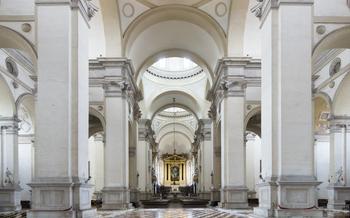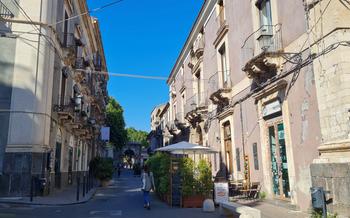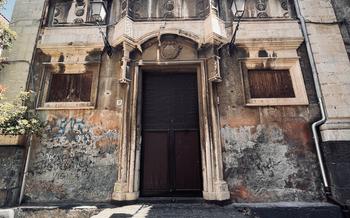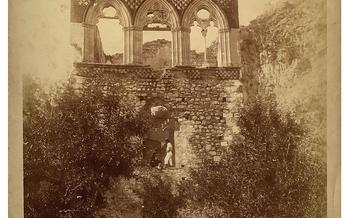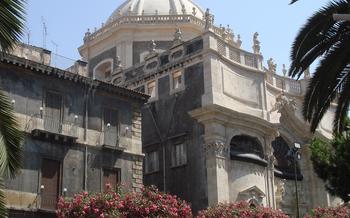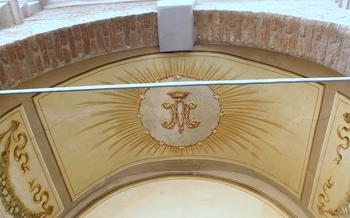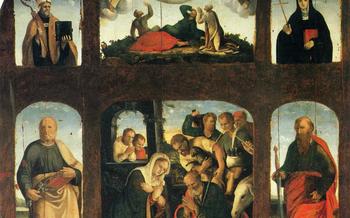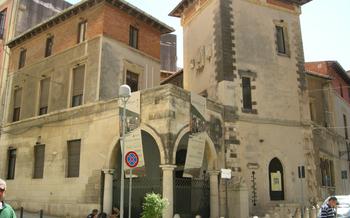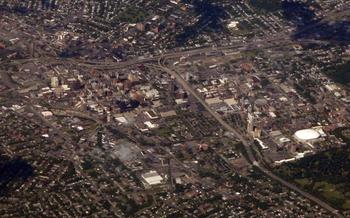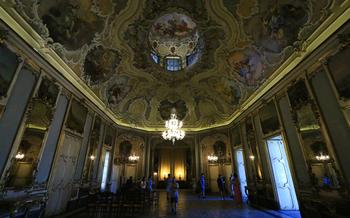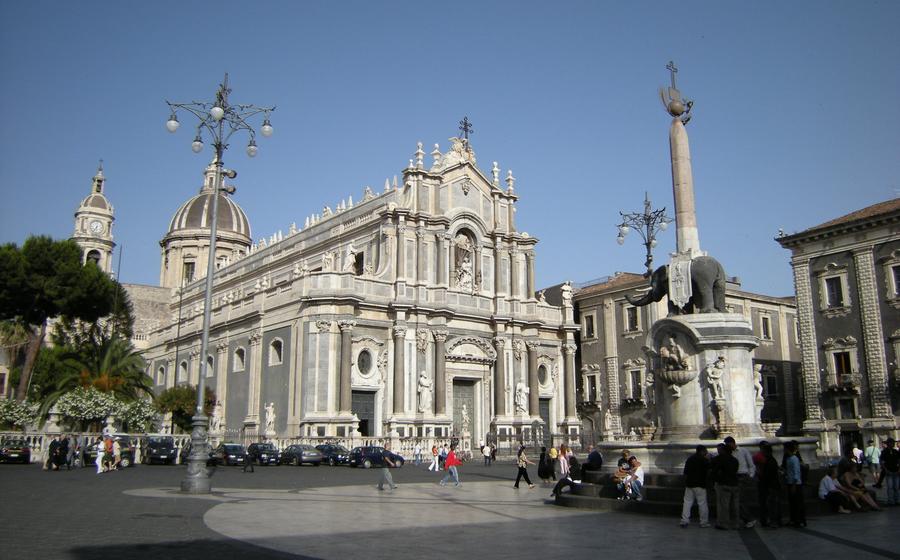
Basilica of San Placido
- Introduction
- Architectural significance
- History of the Basilica di San Placido
- Architecture of the Basilica di San Placido
- Layout of the Basilica di San Placido
- Altars and Artwork
- Monastery of San Placido
- Catacombs of the Basilica
- Opening Hours and Admission
- Location and Accessibility
- Dress Code and Etiquette
- Photography and Videography
- Accessibility for Disabled Visitors
- Guided Tours
- Insider Tip
Introduction
Catania, a city brimming with Baroque splendor, boasts a rich tapestry of historical and cultural treasures. Among these gems, the Basilica of San Placido stands as a testament to the profound faith and architectural mastery of its creators. As you wander through the lively streets of Catania, make sure to include this sacred haven in your itinerary. Here, we embark on a journey through time, exploring the fascinating history and architectural wonders of the Basilica of San Placido.
Architectural significance
Built in the 18th century, the Basilica of San Placido showcases the brilliance of Sicilian Baroque architecture. Its graceful curves, intricate carvings, and harmonious proportions create a sense of awe and wonder in every visitor. The harmonious blend of various architectural elements, including Corinthian columns, elegant arches, and a majestic dome, adds to the grandeur of this sacred space.
History of the Basilica di San Placido
The Basilica di San Placido was founded in the 12th century by Benedictine monks who had fled the Abbey of Montecassino due to the Saracen invasions. They brought with them the relics of Saint Placidus, a Benedictine martyr who was killed in the 6th century. The monks built a small church to house the relics and dedicated it to Saint Placido. Over the centuries, the church was enlarged and embellished, and in the 16th century, it was rebuilt in the Baroque style. The basilica was damaged by earthquakes in the 17th and 19th centuries, but it was restored each time. The latest restoration was completed in 1990.
The basilica is located in the heart of Catania, on Via Vittorio Emanuele II. It is a popular tourist destination, and it is also a functioning parish church.
-
The basilica was founded in the 12th century by Benedictine monks who had fled the Abbey of Montecassino due to the Saracen invasions.
-
Over the centuries, the church was enlarged and embellished, and in the 16th century, it was rebuilt in the Baroque style.
-
The basilica was damaged by earthquakes in the 17th and 19th centuries, but it was restored each time.
-
The latest restoration was completed in 1990.
-
The basilica is a popular tourist destination, and it is also a functioning parish church.
Architecture of the Basilica di San Placido
The Basilica di San Placido stands out with its impressive Baroque architectural style. The external facade features intricate carvings, decorative moldings, and a grand central portal. The interior boasts a spacious nave, flanked by majestic columns and graceful arches, leading to a striking high altar. Visitors are captivated by the opulent frescoes and paintings adorning the ceiling and walls, depicting biblical scenes and the life of Saint Placido. The intricate details and vibrant colors of these artworks contribute to the basilica's opulent atmosphere. The overall design of the basilica showcases the fusion of Baroque grandeur with the principles of the Benedictine order, prioritizing simplicity, symmetry, and functionality.
Layout of the Basilica di San Placido
The Basilica di San Placido features a spacious and well-lit interior, divided into a central nave and two lateral aisles. The nave is lined with massive columns that support the vaulted ceiling, creating a sense of grandeur and spaciousness. The aisles are narrower and feature smaller altars and niches, showcasing various religious artifacts and artworks.
One of the most striking features of the interior is the Cappella dell'Angelo Custode, located on the right side of the nave. This chapel is dedicated to the Guardian Angel and boasts a stunning altarpiece depicting the Virgin Mary with the Infant Jesus and the Archangel Michael. The altar is adorned with intricate carvings and colorful marble, making it a true masterpiece of Baroque art.
Altars and Artwork
The main altar of the Basilica di San Placido is a magnificent work of art in itself. Crafted from polychrome marble, it features a splendid altarpiece depicting the Martyrdom of Saint Placidus. The altarpiece, attributed to the renowned painter Giovanni Lanfranco, portrays the saint's final moments as he faces persecution and death for his unwavering faith.
Throughout the basilica, visitors can admire a collection of notable paintings and sculptures that grace the various altars and side chapels. Among these artistic treasures is the painting Saint Placidus in Glory by Mario Minniti, an esteemed artist from Catania. Minniti's depiction of the saint's heavenly ascent is a testament to the devotion and admiration held for Saint Placidus within the Benedictine Order and beyond.
Another noteworthy artwork is the sculpture Saint Placidus and the Lion by Innocenzo Spinazzi. This captivating sculpture portrays the legendary encounter between the saint and a fierce lion, symbolizing his triumph over adversity and his unwavering faith in the face of danger.
Monastery of San Placido
Founded in the 14th century, the Monastery of San Placido is an integral part of the Basilica di San Placido complex. It played a crucial role in the Benedictine order's religious and cultural activities throughout its history.
The monastery served as a residence for the Benedictine monks who tended to the basilica and its surrounding religious community. Within its walls, the monks led a contemplative and prayerful life, dedicating themselves to the study of theology, philosophy, and the arts.
Over the centuries, the monastery also functioned as a center of learning and scholarship. Its library, once renowned for its rich collection of manuscripts and texts, attracted scholars and intellectuals from across the region. The monks diligently copied and preserved ancient manuscripts, contributing to the dissemination of knowledge and the preservation of cultural heritage.
Although the monastery is no longer inhabited by Benedictine monks, its legacy continues to resonate within the basilica complex. The serene atmosphere and the presence of centuries-old artwork and architecture transport visitors back in time, allowing them to glimpse into the spiritual and intellectual life of the Benedictine order.
Catacombs of the Basilica
Beneath the Basilica of San Placido lies a hidden treasure: the ancient catacombs. While their exact origins are shrouded in mystery, they are believed to date back to the early Christian era, serving as a burial ground for the Benedictine monks and other members of the community. Discovered in the 19th century during restoration work, the catacombs offer a glimpse into the lives and customs of early Christians in Catania.
Visitors can explore the winding tunnels, lined with niches that once held the remains of the deceased. The walls are adorned with simple yet evocative frescoes, depicting scenes from the Bible and early Christian symbolism. Inscriptions and epitaphs in Greek and Latin provide clues about the lives and identities of those buried here.
The catacombs not only offer a glimpse into the past but also serve as a reminder of the deep-rooted faith and traditions of the Benedictine Order. They stand as a testament to the continuity of Christian life and worship in Catania, from the early centuries to the present day.
Opening Hours and Admission
The Basilica di San Placido welcomes visitors with open arms on all days of the week. During the summer months (from April to October), its doors remain open from 8:30 a.m. to 12:00 p.m. and from 4:00 p.m. to 7:00 p.m., allowing ample time for exploration and reflection. In the winter months (from November to March), the basilica slightly adjusts its hours, opening from 9:00 a.m. to 12:00 p.m. and from 4:00 p.m. to 6:00 p.m.
Admission to this sacred site is absolutely free, inviting all who seek spiritual solace or artistic inspiration to step inside without any financial burden. The basilica's doors are always open, welcoming pilgrims, travelers, and locals alike to bask in its serene atmosphere and marvel at its architectural grandeur. Whether you are a devout believer, an art enthusiast, or simply a curious wanderer, the Basilica di San Placido offers a sanctuary for contemplation, exploration, and spiritual connection.
Location and Accessibility
The Basilica of San Placido is situated at Via Vittorio Emanuele II, 139, in the heart of Catania's ancient city center. It stands proudly near the bustling Piazza San Placido, showcasing its intricate facade amidst lively streets and historic landmarks.
To reach the basilica, visitors can conveniently use public transportation. Catania's efficient bus network offers several lines with stops close to the church. The closest stops are "Stesicoro" for the 427 bus and "Giuffrida" for the 532 and 633 buses.
Alternatively, visitors opting for a scenic walk can stroll through the charming streets from Catania's central landmarks. The basilica is approximately 10 minutes away on foot from the vibrant Piazza del Duomo and the majestic Catania Cathedral.
Dress Code and Etiquette
As a place of worship, the Basilica of San Placido commands a certain level of respect and decorum. Visitors are expected to dress modestly and refrain from wearing revealing or overly casual clothing. Shoulders and knees should be covered, and shorts or tank tops are generally not appropriate. While the basilica welcomes tourists, it is important to remember that it is an active religious site and visitors should be mindful of ongoing services or ceremonies. Maintaining a respectful silence and avoiding disruptive behavior is essential. Photography and videography are permitted, but using flash photography or tripods may be restricted.
Photography and Videography
Photography and videography are generally permitted within the Basilica of San Placido, allowing visitors to capture the stunning interior and artwork. However, to ensure a respectful and serene atmosphere, certain guidelines must be followed. Flash photography and the use of tripods are strictly prohibited, as they can be disruptive to other visitors and potentially damage the delicate artworks. Instead, visitors are encouraged to use natural light and adjust their camera settings accordingly.
When taking photographs or videos, it is important to be mindful of the privacy of other visitors and avoid capturing them in a way that may be intrusive or disrespectful. Additionally, it is essential to refrain from using the flash, as the sudden burst of light can be startling and distracting to those around you. By adhering to these guidelines, visitors can ensure that they capture their memories of the Basilica of San Placido while respecting the sanctity of the space and the privacy of others.
Accessibility for Disabled Visitors
The Basilica di San Placido embraces inclusivity and strives to welcome visitors with disabilities. The basilica is equipped with thoughtfully designed features to ensure accessibility for all. Wheelchair users and visitors with limited mobility can comfortably navigate the basilica's interior through designated ramps and accessible entrances.
To further enhance the experience, the basilica provides wheelchairs upon request, ensuring that visitors with mobility challenges can fully participate in their visit. Additionally, the basilica staff is trained to assist visitors with disabilities, offering guidance and support throughout their visit.
With these accessibility features in place, the Basilica di San Placido invites visitors of all abilities to immerse themselves in its sacred ambiance and rich history.
Guided Tours
Guided tours of the Basilica di San Placido are available on request, providing an immersive and informative experience for visitors. These tours are led by knowledgeable guides who offer insights into the history, architecture, and religious significance of the basilica. The tours usually last for about an hour and are conducted in multiple languages, including English, Italian, and Spanish. Visitors interested in booking a guided tour can inquire at the basilica's reception or through authorized tour operators. These tours offer a unique opportunity to delve deeper into the basilica's rich history and cultural significance, making them an excellent choice for those seeking a more comprehensive understanding of this sacred site.
Insider Tip
To truly immerse yourself in the spiritual essence of the Basilica di San Placido, plan your visit for a weekday morning. The basilica is typically less crowded during these hours, allowing you to wander freely, soak in the tranquility, and fully appreciate the architectural intricacies without distractions. Moreover, if you're fortunate, you might even catch a glimpse of the Benedictine monks engaged in their daily prayers and devotions, adding an authentic and serene ambiance to your visit.
